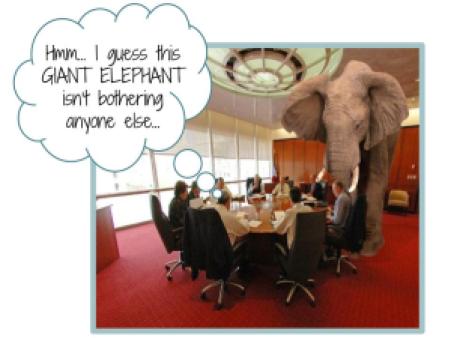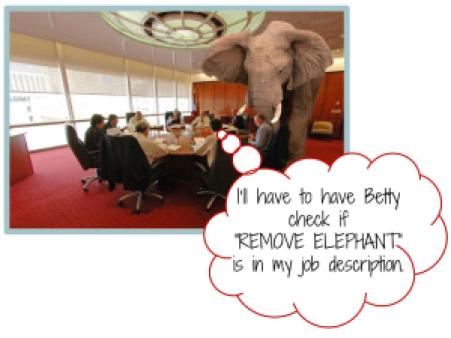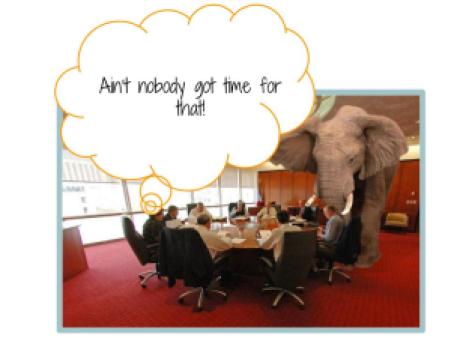If Not You, Then Who?

Identifying problems is important. It is certainly the first step toward a solution. However, as important as the first step is, it is worthless if it never goes any further. From my observation, there seem to be three main barriers to educators taking action: assumptions, roles, and time. These barriers affect our reactions to small issues, as well as, large problems. Unaddressed, these concerns become gigantic elephants within our organization, and as you can imagine, we get little done when we spend our days bumping into elephants. I do not present this blog post as an innovative solution to all of our education woes, rather it serves as a reminder. We need to be aware of these barriers, so elephants can be addressed and we can move our organizations forward.
Assumptions
Sometimes a problem is so obvious to us, we just assume that others have recognized the issue: the copier that has been broken for a week, the student who has been absent for countless days, or the pacing guide that is misaligned. These things worry us or drive us crazy, but we assume they are already being addressed or, perhaps, we assume they are being ignored for a reason. 
Address the Elephant: My advice here is simple, no problem is too obvious to discuss. Often times, if you have a question, someone else has is it, too. Have the confidence to speak up. It could be your question that spurs a necessary change.
Roles
During high school and college I worked at Sesame Place, a children’s theme park in Langhorne, PA. As a lifeguard, if I walked by guests having an inappropriate screaming match, I immediately called for a Supervisor and stood by waiting for help. A year later, I found myself in the Supervisor role. As I arrived on scenes of irate guests, I found myself wondering what the lifeguard had said to defuse the situation prior to my arrival. Do titles really determine who is qualified to identify and solve problems?
 Address the Elephant: Finding solutions to specific challenges often does not fall into any one job description. Typically, the best solutions are created by a diverse group of stakeholders. You do not need a title to be a leader, in fact, Mark Sanborn wrote a whole book about it (another interesting book on this topic: Leading Up: How to Manage Your Boss So You Both Win, by Michael Useem). As building and district leaders, we should be empowering our teams to develop solutions – vertical problem solving yields sustainable solutions.
Address the Elephant: Finding solutions to specific challenges often does not fall into any one job description. Typically, the best solutions are created by a diverse group of stakeholders. You do not need a title to be a leader, in fact, Mark Sanborn wrote a whole book about it (another interesting book on this topic: Leading Up: How to Manage Your Boss So You Both Win, by Michael Useem). As building and district leaders, we should be empowering our teams to develop solutions – vertical problem solving yields sustainable solutions.
Time
“I don’t have time for this.” How many times a day do you think we hear this phrase (and sometimes from our own mouths)? There are times it is true. No one has time for a flooding toilet, a car that won’t start, or a dog that just ran out the front door. We are all faced with issues we feel we do not have time to work through, but what are we communicating to our colleagues if we spend time actively avoiding an issue?
 Address the Elephant: Reframe time related issues. Organizing our supply closet, making a challenging phone call home, or having a fierce conversation with a disgruntled colleague, can be viewed as an investment of our time. Investing the time now will surely save us time in the future. You may feel like you do not have time to devote to these tasks, but really, you don’t have time not to.
Address the Elephant: Reframe time related issues. Organizing our supply closet, making a challenging phone call home, or having a fierce conversation with a disgruntled colleague, can be viewed as an investment of our time. Investing the time now will surely save us time in the future. You may feel like you do not have time to devote to these tasks, but really, you don’t have time not to.
The way elephants are addressed says a lot about the culture in your organization. So, what are your elephants saying about you?
For more on school culture in our building, check out this recent post by our principal, Mike Kelly – @PrincipalMKelly: Making School Culture Our Focus.



